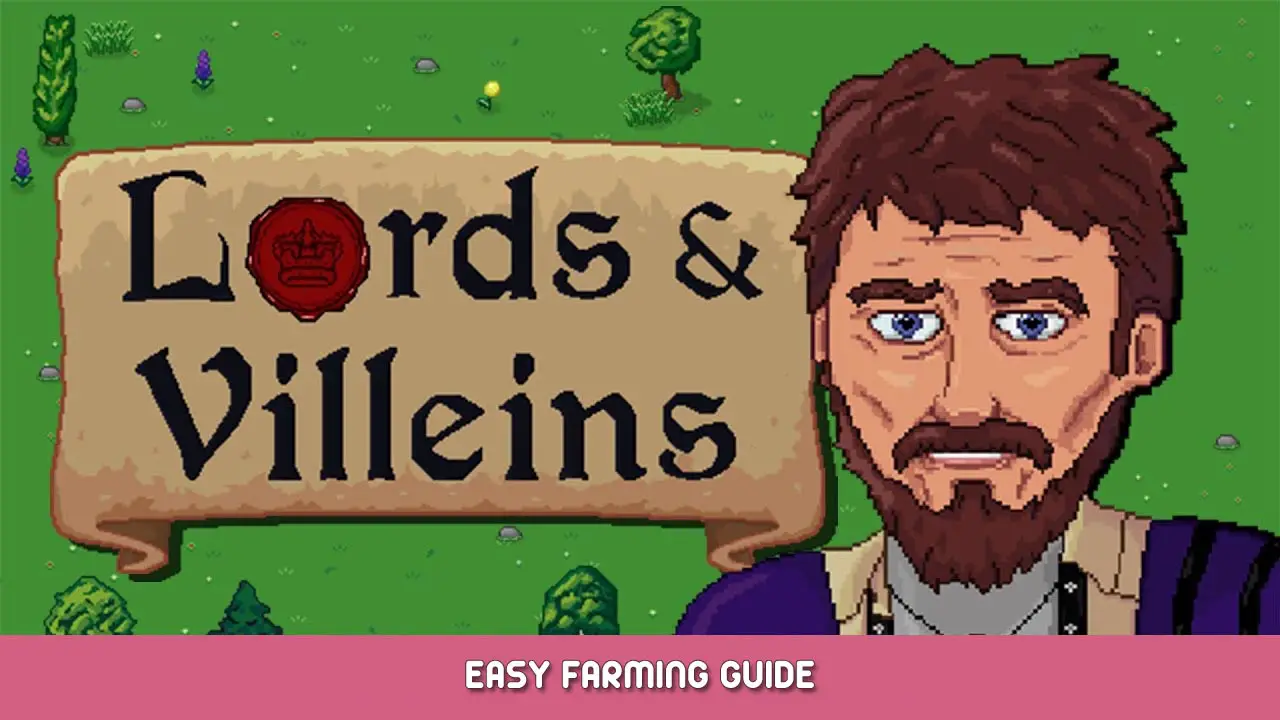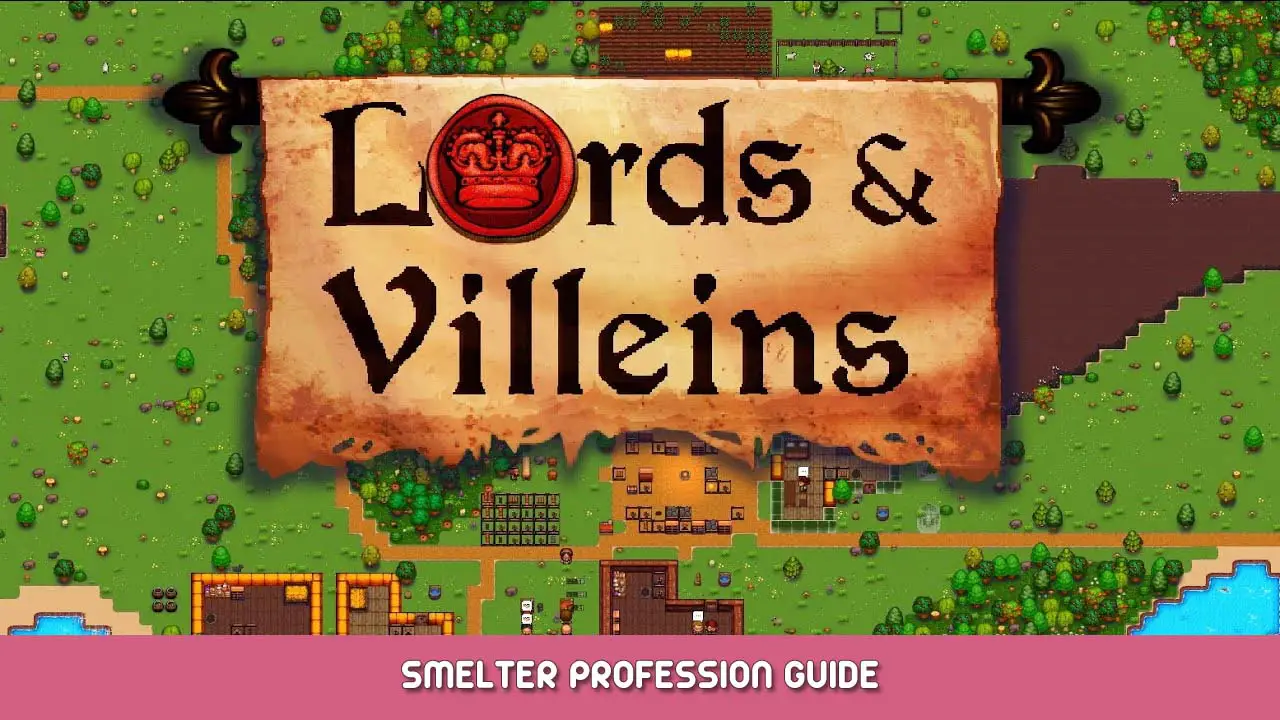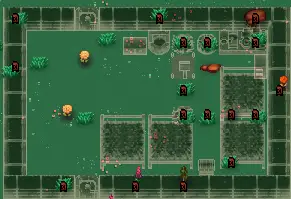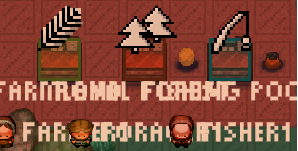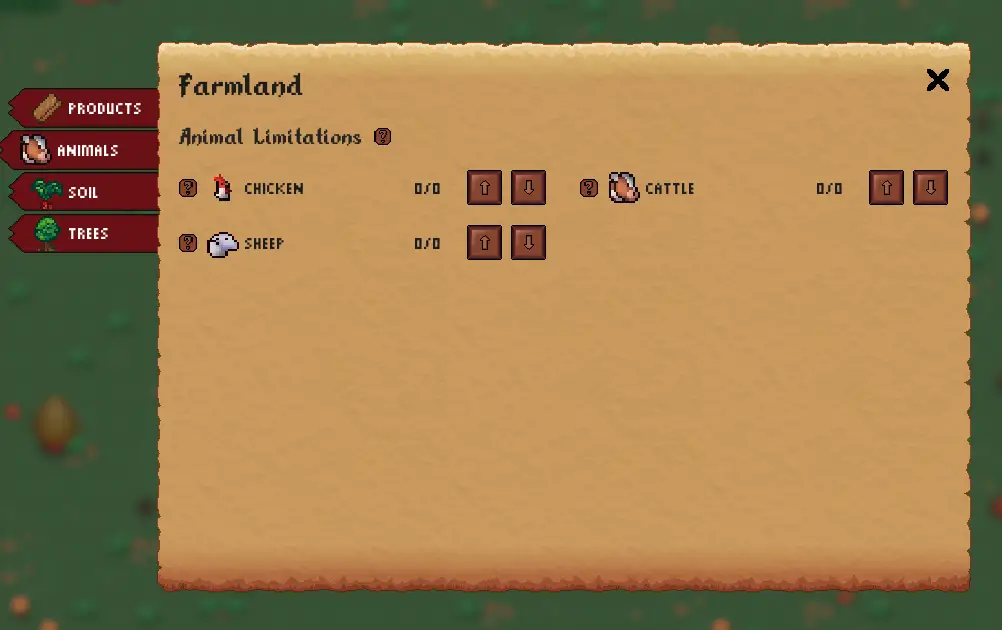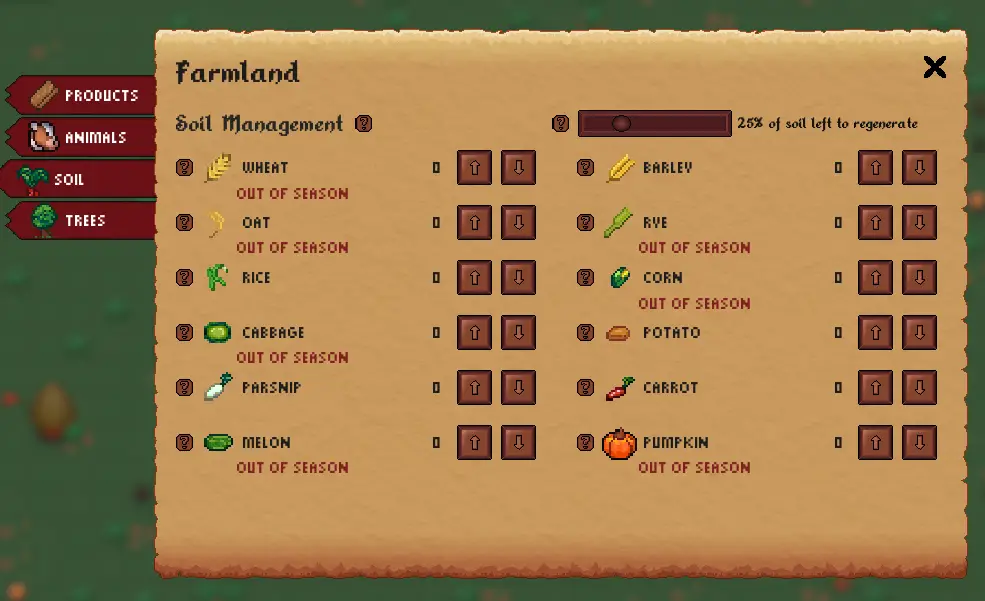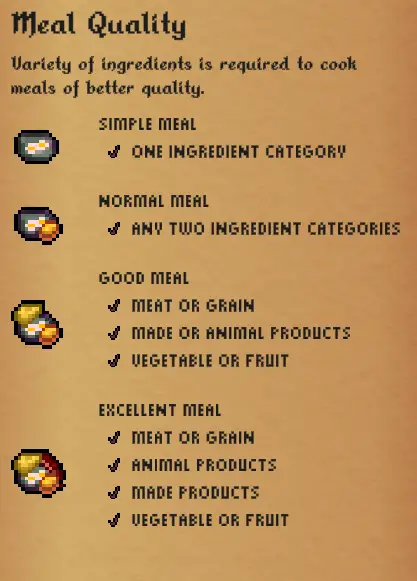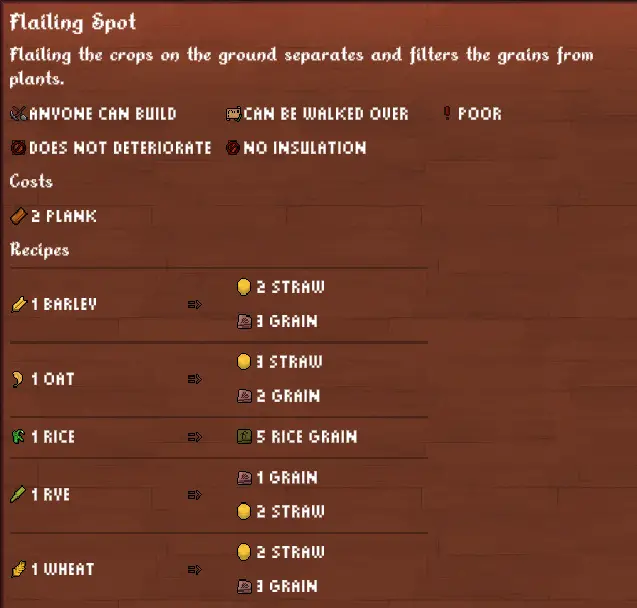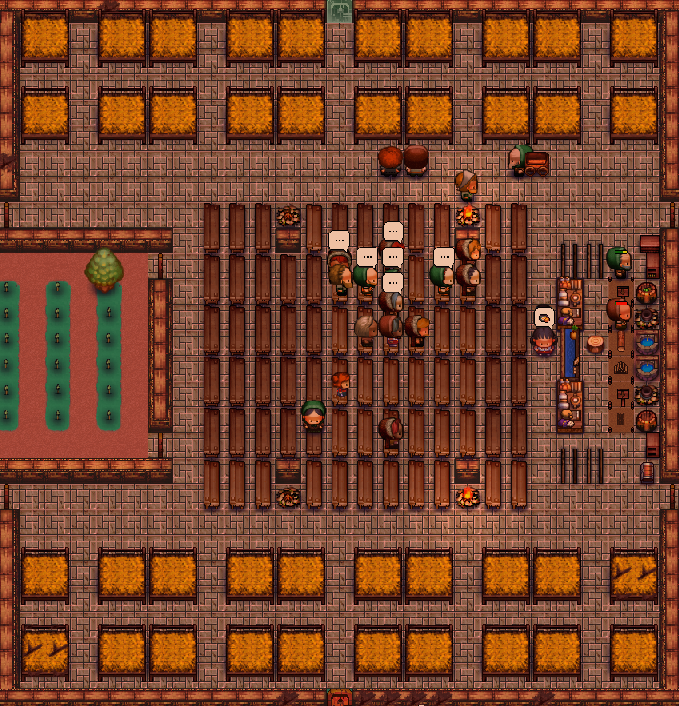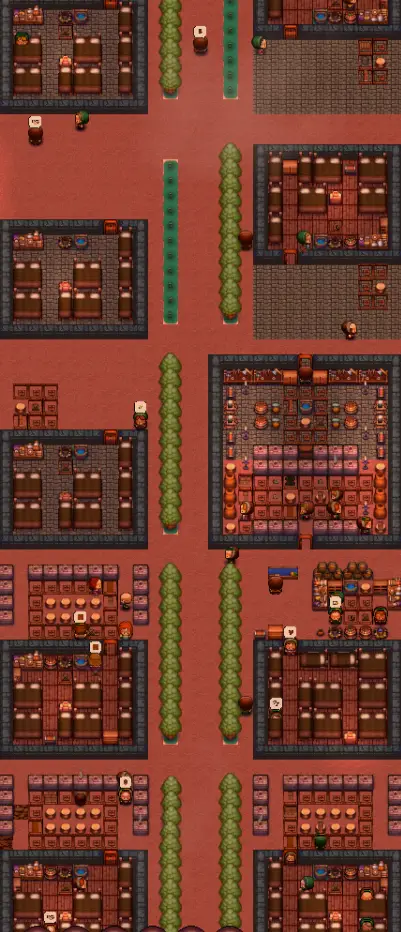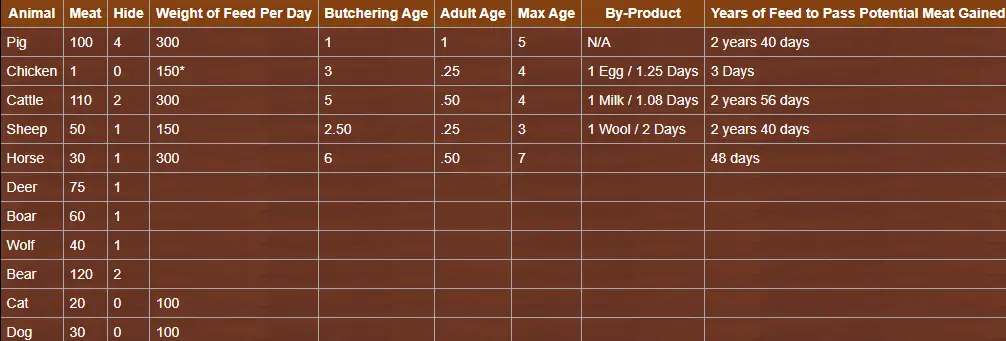Steps to a successful farming life.
Invoering
This guide will use tables from the L&V Wiki Page that I have collected data on. Showing all Crops/Trees you can plant and their yields. With the purpose of being the go-to guide for what to do to get a successful farm working and keeping it going.
Farming is the backbone of your village and should be your first priority for new families wanting to join after starting a new game. Late game you will want far more farming families than any other profession. Currently the only fail-states in the game are your town starving to death or your entire ruling family dying in a fight.
How do I farm?
To get started you will need a home for your farming family. Housing should be the first thing you build for every new family you add. Try to give yourself some room if you are starting out to allow your families to grow. Once you are more experienced with the game you will have a better idea of the zone size you want for each family as well as your target size of the family. Generally with farming families the larger the better, naar mijn mening 4 is the smallest farming you will want to invite to your village. The largest farming family I’ve had so far was 52 members but with recent changes 10+ is your ideal.
With that done we can turn to the farm itself. Start by placing farming soil. My rule of thumb for crops and the size you want your field to be depends on a few things, what type of economy are you planning to use and how large the family is.
Socage vs Stewardry.
This is a long debate that I’ll cover in another guide for now we’ll just give a brief explanation. “Socage” is the farmers trying to sell their crops and at the end of the season you collect part of their production. “Stewardry” you take all their production at the end of the season and then pay them for their service. The only important things to know is “Socage” you need a member of the family to sell their products.
Opmerking- In the upcoming update passive storefront will be introduced, allowing storefronts at a persons home to be run without an active salesperson present, and they will only move to the storefront when a customer is nearby. Under “Stewardry” no saler is needed tho they will still try to man a storefront in the market. If you use “Stewardry” it is best to give individual families storefronts in a central marketplace rather than using the marketplace zone so you can control your workers. (See image below).
TLDR- Socage Veggies = Family Members -1(45 tiles per worker) so a family of 6. 5 Workers x 45 Tiles = 225 Tegels
Socage Grains = Family Members -1 (15-20 tiles per worker) so a family of 6. 5 Workers x (15-20 Tegels) = 75-100 Tegels
Stewardry Veggies = Family Members (45 tiles per worker) so a family of 6. 6 Workers x 45 Tiles = 270 Tegels
Stewardry Grains = Family Members (15-20 tiles per worker) so a family of 6. 6 Workers x (15-20 Tiles = 90-120
The general consensus for farms is you want to specialize them, with your first farm that should be food production but with recent changes it doesn’t hurt to have a little straw production.
What Can I Plant?
So onto what can we do with farms. Lets look at the priorities screen.
So the “Products” screen will determine what products will be made in the zone. A good habit is to turn off production for everything in the farm zone, unless the farm will specialize in that product. If you leave grain on and the farm doesn’t produce wheat/barley/oats/rye they will try to buy those products from the market to flail them. The same is true for the other products except Apples and Pears.
De “Animal” screen we will cover later in this guide.
“Bodem” is where we want to focus on right now. This is where you will decide which crops to plant in your available farming soil. It is important to understand how the priority system works and the seasons. If you turn the setting to how I have them set, the crops that have the “out of season” warning will not be planted til their season. In our example only Barley, Rijst, and Carrots will be planted. The total of the available crops is 3, with each set to 1:1:1. Dus 1/3 of your soil will planted as Barley, 1/3 of your soil will planted with Rice, en 1/3 of your soil will be planted as Carrots. If you increase any of the numbers it will increase the fraction of available soil planted as that crop. As long as the ratios remain the same they will plant equal amounts.
Another important thing to note on this screen is the “% of soil left to regenerate” at the top of the window. What this does is if you have 100 tiles of farming soil and 25% of soil is left to regenerate, 25 tiles will not be planted. The tiles with the lowest soil quality will be picked to be left empty. Soil quality determines how fast crops grow but does not effect the yield. Trees do not suffer from soil quality, once they are fully grown they will continue to produce fruit. If you are more experienced you can slowly reduce this number overtime down to 0 and not have any soil quality lose. It is a great tool to use if you notice your soil quality for most of your field has reached poor or lower quality w/o having to turn off planting entirely. For newer players, this setting can be mostly ignored.
Alright now what crops should I plant? 
This is a complete list of the crops that can be planted, how long they take to grow, their yield, gewicht (which we will cover in the meals guide), as well as the weight per day.
Groenten
At first glance when you look at the graph above the important things to take away are seasons, type, and weight per day. In general you want to plant crops that have overlapping seasons. The reason for this is so you can plant the crop is Spring and still be able to harvest them in Summer. Otherwise plants will go rotten when the seasons change. Also crops that only have a single season growth usually only allow for 1 harvest per season. (Looking at you pumpkins…) Because of this we are only left with Corn, Kool, and Carrots.
In this image we see that normal meals (what your peasants eat) only need 2 different types of ingredients. Carrots produce so much more than Cabbage, there is no need to plant anything other than Carrots. So our first farm well want to plant carrots and corn. One special exception to the rule we’ve set for ourselves so far is Rice. Rice while not as productive as the other crops it will allow our veggie farm to still work during Winter. What usually happens is they will plant Rice and Carrots in Spring, Carrots and Corn in Summer, Corn and Rice in Fall, and then spend most of the Winter flailing the Rice that was planted in the earlier seasons.
The priority system of the farm is
– Crop is planted
– Crop is Harvest
– They haul the veggies and corn to barrels, and grain and rice to ground storage
– A Worker will take the grain/rice to a flailing spot and flail it
– Straw, Korrel, and Rice Grain is made from the flailing
– It is hauled to the appropriate storage, if no storage is already storing the product they haul it to the closest storage.
Because of this if your farm is large enough they will spend all their time sowing plants and harvesting and only flail during the Winter. If you want to speed up flailing or notice you aren’t flailing all of your crops in Winter before Spring starts reduce the size of your farm.
Het’s important to note that this is the best starter setup after your first 3 farms you are more than able to plant whatever you like. The game isn’t that hard and part of the fun is playing and designing the way you want
Grains
Before I get into Grains, due to recent building changes straw is very important early game. What I tend to do with my first farm is turn on Barley and Oats, and turn off Barley after the first Spring. I keep this farm planting oats until I get my fulltime grain farm rolling.
Reposting Previous Graph so we can refer to it for grains.
Grains are more of a middle game item, early without a Miller, Bakker, and Butcher there is no use for them. So I tend to make my 3rd Farming family my grains producer. Again lets turn to the above graph. Seasons is what we are looking at for grains. So we have Barley which is the only grain that can be grown in Spring. That leaves us with Wheat, Oats, and Rye
In this image we can see out of Wheat, Oats and Rye. Wheat is the best for Grain while giving decent straw, and Oats is the best for Straw while giving good grain. Rye is a trap and should never be planted.
The same priority from veggies applies here, you want to hit that sweet spot of the farmers planting and harvesting all year and then flailing all Winter. If you want to speed up flailing or notice they arent getting thru all your grain plants during Winter reduce the size of your farm.
Fruit Trees
Orchards are typically my second farming family setup since they are still providing food. The most important thing about them is once they reach 100% growth they will never need to replanted again. Er zijn er maar 2 Trees in the farming zone. Apples or Pears. Both have their strengths and weaknesses. While they both give the same amount of fruit when harvested the only difference is when they are harvested and how many times a year.
Apples can be harvested 4 times a year. Start of Summer, Middle of Summer, End of Summer, and the start of Fall
Pears can be harvested 3 times a year. End of Fall, Start of Winter, and End of Winter.
So if youre looking for just the amount they can produce Apples are your go to. This doesn’t mean you cant plant 2 fields, 1 With apples and 1 With pears or 1 Large field of both. That way this farming family will have work for 75% of the year.
What I will add is my personal opinion. I think it is still best to focus on just 1, that being apples. That is because fruit trees unlike their crop counter-part can be harvested by anyone. What I like to do is have 1 family harvesting just Apples. Then I give every family in town their own small Pear grove. This way the farming family is not competing with the rest of the town. They also will provide them with a little food through the year. I give them pears since they are harvested in Winter which is usually when the least work is done, and they only need to harvest them 3 keer.
This is a picture of an early Inn. This lowers the food costs for the inn (their main spender). You can see on the back side there is a small grove of Pear trees. I do this for every family, tailors/butchers/miners/blacksmiths. About a row of 8-11 trees per home. This allows them some food even if they are struggling just enough to keep them alive. To achieve this you will need to place a Farming Zone where you want your trees planted, assign it to a Farming/Forager family with the correct priorities set, when the trees are planted reassign them to the family living nearby. They will also try to sell their excess which brings in a little money. I also use this method for what I coined “Pearfare”. Late game some professions can struggle with money (Blacksmiths/Leatherworkers/Tanners) by giving them a little farm land with pears set to Stewardry they will receive a paycheck every season whether they harvested any pears or not. With the entire town passively gathering fruit and a modest 20% tax on them you will gather thousands of pears come Tax Payment Day.
Dieren
This brings us finally to Animals. Again I can not stress the importance of specialization and if you plan on not using the stables to house all your animals 1 type should be given to each family. If a family is tending to animals you want them to only handle the animals and just buy enough to where they are not wasting time sitting around. The reason for this is shearing/milking takes a lot of time and is low on their priority so if they are planting/harvesting crops they will not tend to the animals. They will also eat crops if their allowed area includes fields. Animals are a mixed bag, and generally you can play the entire game and the only animals I would say that are needed are Sheep and Pigs. Each animal type needs their own feeder with a max of 5 animals per feeder but they will also graze on grass if given enough space. Some of this part will bleed over into butcher/stables guide
Sheep provide wool and pigs provide meat and hides. That doesn’t mean the other aren’t useful.
This is a complete list of every animal in the game as well as how much they eat and how much you get in return.
VarkensPigs give the highest amount of hide per animal but they also eat the highest amount (same as cattle and horses) but they are the only animal that will eat acorns. As you see from the graph tho pigs only give you a return if they are slaughtered before they reach 2 jaar 40 days old. To counter act this I employ the starvation method. Basically you want to set the target amount of pigs higher than the feeders in their pen. If you set the target to 20 but only put 3 feeders assigned to pigs. This way any time they breed over 15 the rest will starve. (yes yes I know the warning is annoying). What this allows is a piglet of just a few days will die. When it is butchered it will give the full amount of hide and meat as a full grown pig. This method can be done with any animal. Taming of pigs in the wild has been removed from recent patches so the only way to get more pigs is from breeding and buying from caravans. For this reason I suggest having pigs raised by your stables and your stables alone since your foragers will try to sell all the pigs they buy to the butcher and they will never breed.
KippenChicken in the graph give next to no meat when butchered so their main purpose is Eggs. Each Female Chicken will lay 1 egg every 1.25 dagen. Which isn’t a lot and we’ll cover that in the meal guide. Their true secret power lies in their diet. It says they eat 150g of feed per day but if you give chickens no feeder in their pen they will happily peck the ground for their own food. Making them essentially free food printing machines. They will reproduce to the set target of their zone and honestly as long as you aren’t feeding them set it to 99 and just harvest eggs all day. They need a chicken bed each tho in order to produce eggs so space is your only limiting factor.
CattleCattle will produce roughly the same meat as a pig but they have the added by-product of producing Milk, which can then be turned into cheese or butter. Cheese is generally the best of the two options since you make 3 cheese per 1 milk with a churn. You can only make 2 Butter from 1 Melk, that first needs to be boiled in a Cauldron and then cooked at a Cooking Table. The amount of extra work for less return isn’t worth it. Usually if these are kept in the stables your workers will eat/drink all the milk before if can be sold. If you give the cattle duty to a farmer and all other animals are being cared for in the stables they will sell their Cows to the butcher before they produce any milk. Until this is changed there isn’t much use for Cattle.
SheepSave the best for last. These little beauties are where the real show is. Wool wool wool. In order to keep your village from turning into a hippy commune you will need to care for sheep. I usually start looking for these guys at the caravan marketplace as soon as I can. You want to have them in town and being sheared before the Tailors (I suggest 2 families) show up so you can build a stockpile. Gebruikelijk 4 sheep is enough for 1 tailor family but I always go overboard with them and my warehouse grows to show it with all the chests you will need to house the wool. Same for Cattle applies here tho If you plan to house all your animals in the stables do not allow farmers to handle sheep, they will sell your hawk-eye purchases to the butcher and you’ll have to wait for more to arrive. RNG is RNG
The priority system for caring for animals is
-Filling Feeders
-Grooming Horses
-Shearing Sheep
-Gathering Eggs
-Milking Cows
Because cows are so low on the priority if you house all your animals in the stables rarely will your stable hands be able to milk them all in a day. So the decision is either have farmers handle the animals, or the stables never both.
Dat is alles wat we vandaag hiervoor delen Lords and Villeins gids. Deze handleiding is oorspronkelijk gemaakt en geschreven door Nowei. Voor het geval we er niet in slagen deze handleiding bij te werken, U kunt de laatste update vinden door dit te volgen link.
